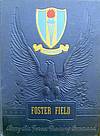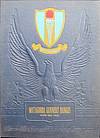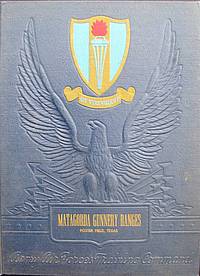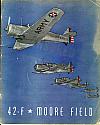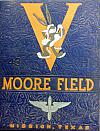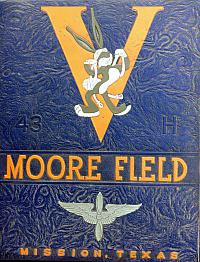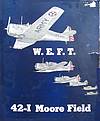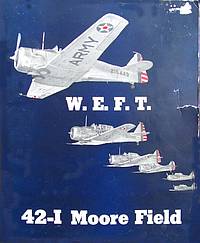 |
Thank You Contributors! |
To view items in the collection, you must enable JavaScript in your Internet browser. You can find instructions at enable-javascript.com.
Search terms must be 4 characters or longer. Words like the, USA, and to are ignored. |
![]() Use Browse the Collection to better find items by Air Field or Class/Unit Number.
Use Browse the Collection to better find items by Air Field or Class/Unit Number.
(Site Details)
Hide
Brief History of the Matagorda Gunnery Ranges
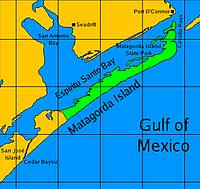
Matagorda Island
Matagorda Island is located 7 miles from Port O'Connor, Texas.
The history of the Matagorda Island and vicinity dates back almost as far as recorded American history itself; even though few history books contain any mention of these locations, they have played an important part in the building of our American continent and way of life.
In 1682 LaSalle descended the Mississippi River to its mouth and conceived the idea of founding there a colony in the name of the King of France. Historians believe that LaSalle desired not only to establish control and develop the valley of the Mississippi, but also to use that stream as a direct connection to Canada. French explorers in the interior of North America had long dreamed of finding a way to the mines of North Mexico, but as France and Spain were continually at war or on the verge of war, it became necessary, if these dreams were to be realized, to protect the Gulf of Mexico and to rid it of roving Spanish buccaneers. When LaSalle returned to France, he proposed to establish a colony on the Gulf, not only as a means of controlling the Mississippi Valley and the northern Gulf shore, but also as a base of attack upon the Spanish treasure fleets and upon the northern provinces of Mexico, should war break out.
In 1684 LaSalle set sail from France with approximately 400 people and four ships in an attempt to organize a colony on the Gulf Coast to fulfill his desire for protection of the Valley of the Mississippi. For reasons which have never been fully explained, the mouth of the Mississippi was missed and a landing made near Pass Cavallo on Matagorda Bay. This was in late November 1685; and it was in the narrow straits of Pass Cavallo that LaSalle lost the first of his four ships. The first landings were made near what is now known as Port O'Conner, but soon this small expedition went to pieces. Some of the colonists died from sickness and others were killed by the Indians. During the course of further explorations in attempting to locate the mouth of the Mississippi, the remaining ships were wrecked on the dangerous shoals of Matagorda Peninsula. Only a few members of the original colonists survived the terrible scourge of disease or death by Indians. And so the first attempt to colonize this portion of the Gulf Coast ended in almost complete failure.
In the name of Spain Ponce De Leon explored Matagorda Peninsula and vicinity in 1690 searching for the remains of LaSalle's colony. LaSalle's presence in Texas had led the Spaniards to believe that France had designs for this particular area of coastline. During Spain's attempt to colonize Texas, various Americans led successful military expeditions into Texas. Spain devoted most of her missionary and colonization efforts to attempts to civilize the Indians, and it was not until after Mexico won her independence from Spain in 1821 that the colonization of Texas began in earnest.
Martin de Leon brought his first colonists to Victoria County in 1824. These colonists were for the major portion, Spaniards and Mexicans. A few white settlers came, mostly from Southern states and other portions of the United States. By 1860 there were a number of settlements in this vicinity including Victoria, Indianola, and Lavaca. When the War Between the States was declared, few of the inhabitants thought they would see actual fighting, but on November 1, 1862, three Yankee gunboats entered Pass Cavallo, and in the [ensuing] months, fierce battles were fought in and surrounding the city of Indianola. Today remains of trenches and blockhouses can be seen on Matagorda Island and Peninsula.
From the very beginning of colonization t the present time Matagorda Island, Peninsula, and vicinity have been subject to frequent and sudden tropical storms. But even these have not hindered the activities that are carried on along this coast. In 1855 to 1859 very careful surveys of Matagorda Bay and the adjoining land were made by the War Department and by the U. S. Coast Guard, with the view toward establishing a Coast Guard Station in the vicinity, but this was not done until later.
During the past century Matagorda Island and Peninsula were used as large cattle ranches. Facilities for loading and unloading cattle for shipment all over the United States were available on the Gulf Shore of Matagorda Island. The cattle found excellent grazing off the swamp grass and vegetation which cover these islands, and it was not until recent years that this enterprise was discontinued. Remnants of the large cattle herds still remain, along with small portions of buffalo herds that roamed these small islands. In recent years fishermen have heralded the waters surrounding Matagorda Island, Peninsula, and neighboring islands as a "fisherman's paradise." Men from many distant parts of the country travel to this vicinity for fishing and boating. Food-fish are plentiful and the beautiful blue waters of the Gulf of Mexico serve as an excellent setting for many boat trips.
In the not too distant past the United States Government proclaimed these islands a Federal Game Reserve to be used as a sanctuary for wild life. Every year thousands of migratory birds return to spend the winter months in the comparative warmth of the coastal regions. Great numbers of these birds remain the year round, and there is, therefore, an abundance of wild life at any time of the year one may see fit to visit the islands.
Sometime about 1927 the Officers Club of Brooks Field acquired hunting and fishing rights on the northern end of Matagorda Island and established a lodge at that point. This club was later expanded to include the pilots of practically all of the Air Corps stations in Texas. A small detachment of men was placed on duty to maintain the facilities and furnish vital weather information of this vicinity.
While the hunting and fishing club as never lacking in popularity, and there was a considerable amount of airplane traffic in and out of the little grass landing strip for a number of years, it was not until November 15, 1941, that the present activities actually came into being. Foster Field had been established at Victoria as an Advanced Single Engine Flying School, and it was desired that Matagorda Island be made into a gunnery range where both ground and air gunnery practice could be conducted. The Government had acquired practically all of the land on the Island and the Peninsula, and construction of adequate facilities began about this time. The "Old House," as the old club house was known, became inadequate, and a full-grown tent city rapidly came into being. For several months all flights were scheduled from Foster Field and only necessary landings for service were made on the Island. On May 2, 1942, the first class of Cadets from Lake Charles, Louisiana, Moore Field, Mission, Texas, and Foster Field arrived, and flying operations were begun from this base. On August 28, 1942, storm warnings were received, and all personnel with the exception of ten enlisted men and one officer were evacuated. The tropical storm struck the next day and the entire tent camp and all of its facilities were completely destroyed with the exception of the old club house. The flying field was made useless because of great amounts of sand which were left on it.
During the progress of training from what is now called the "Old Camp," two new and modern air fields were under construction, one a short distance down the Island and one about the middle of Matagorda Peninsula. They were similar in detail and included every modern facility for student training. Both of these camps were very near completion when the hurricane struck. The damage was considerable but because of the necessity for continuing fighter pilot training, the Matagorda Island Field was pressed into service a few days after the storm--even before the roofs were replaced on the buildings, and while gaping holes still remained on the runways. This was real combat training under the worst conditions. The Peninsula Camp was placed in operation about three months later, and since that time the student load at both places has increased beyond all expectations.
At the present time, all cadet training is being conducted on Matagorda Island and the A. A. F. Instructors' School (fixed gunnery) is being conducted on the Peninsula.
Source: Transcribed from Army Air Forces Collection, "Matagorda Gunnery Ranges, Matagorda Island, Texas: Wings Over America" (item 000491), AAF Collection, http://AAFCollection.info/items/list.php?item=000491 (accessed 20 February 2014), 1943, pages 8-9.
Source: Location and map from Wikipedia contributors, "Matagorda Island," Wikipedia, The Free Encyclopedia, http://en.wikipedia.org/w/index.php?title=Matagorda_Island&oldid=596216947(accessed February 20, 2014).
Hide
| Image | Locations | TitleFF MM WW | |
|---|---|---|---|
1 | Foster Field; Victoria, Texas, USA Matagorda Gunnery Ranges; Matagorda Island, Texas, USA Port O'Connor, Texas, USA |
Foster Field Class book for advanced pilot classes 43-G and 43-H at Foster Field, Victoria, Texas. Advanced Single Engine Flying Training School. |
|
2 | Matagorda Gunnery Ranges; Matagorda Island, Texas, USA Port O'Connor, Texas, USA Foster Field; Victoria, Texas, USA |
Matagorda Gunnery Ranges, Matagorda Island, Texas Class book for gunnery training squadrons at the Matagorda Gunnery Ranges, and Foster Field, Victoria, Texas. |
|
3 | Moore Field; Mission, Texas, USA Matagorda Gunnery Ranges; Matagorda Island, Texas, USA |
Moore Field Class book for advanced pilot class 42-F at Moore Field, Mission, Texas. This is the first class book produced at Moore Field. |
|
4 | Moore Field; Mission, Texas, USA Matagorda Gunnery Ranges; Matagorda Island, Texas, USA |
Moore Field Class book for advanced pilot class 43-H at Moore Field, Mission, Texas. |
|
5 | Moore Field; Mission, Texas, USA Matagorda Gunnery Ranges; Matagorda Island, Texas, USA |
WEFT Class book for pilot class 42-I at Moore Field, Mission, Texas. Cadets were taught aircraft identification using the Wing, Engine, Fuselage, Tail (WEFT) system. |
|
| |||||
|
|
Series: Different items with the same title. |
|
Copies: Identical items, with different attributes. |
|
Collection: A group of related items. |
Quick Link: https://aafcollection.info/items/list.php?site=MATAGORDA
Curator: Mike Voisin
|
All items in the Army Air Forces Collection are licensed by Mike Voisin under a Creative Commons Attribution-NonCommercial-ShareAlike 4.0 International License. |


